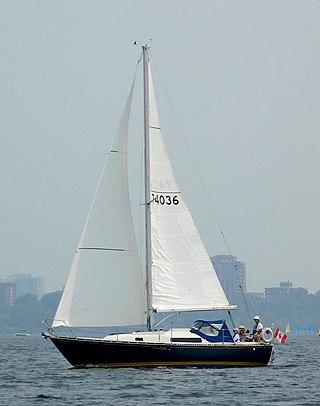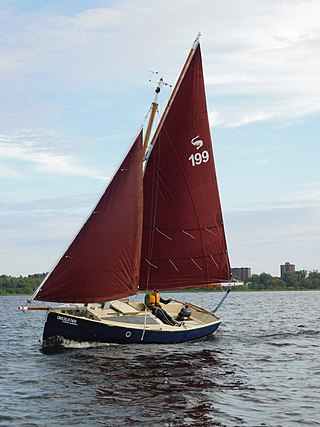Related Research Articles

A cutter is a type of watercraft. The term has several meanings. It can apply to the rig of a sailing vessel, to a governmental enforcement agency vessel, to a type of ship's boat which can be used under sail or oars, or, historically, to a type of fast-sailing vessel introduced in the 18th century, some of which were used as small warships.

The Catalina 30 is a series of American sailboats, that were designed by Frank Butler and later by Gerry Douglas.

The C&C 30 is a series of Canadian and American sailboats, that was first built in 1973.
The Hunter HC 50 is an American sailboat that was designed by the Hunter Design Team as a "long distance express cruiser" and first built in 2000.
The Orion 27-2, also called the Orion 27 Mk II, is an American sailboat that was designed by Henry Mohrschladt as a cruiser and first built in 1981.

The Cornish Shrimper 19 is a British trailerable sailboat that was designed by Roger Dongray, inspired by traditional shrimp fishery boat designs and first built in 1979.
The Cal 39 Mark II and Cal 39 Mark III are a series of American sailboats that were designed by C. William Lapworth as racer-cruisers to fit the International Offshore Rule and first built in 1978.
The Caliber 40 is an American sailboat that was designed by Michael McCreary as a cruiser and first built in 1992.
The Aquarius 24 Pilot Cutter, also called the Aquarius Pilot Cutter 24, Aquarius 24 Cutter and the Topsail Pilot Cutter, is an American trailerable sailboat that was designed by Frank Parish as a cruiser and first built in 1979.
The Com-Pac 23 is an American trailerable sailboat that was designed by Clark Mills as a pocket cruiser and first built in 1978. The boat has undergone design changes over time resulting in a series of improved models.
The Cornish Crabber 17, or just Cornish Crabber, is a British trailerable sailboat that was designed by Roger Dongray as a daysailer and pocket cruiser and first built in 1989.
Cornish Crabbers LLP is a British boat builder based in Rock, Cornwall. The company specializes in the design and manufacture of glassfibre gaff-rigged sailboats and powerboats. It was founded by boat designer Roger Dongray, as well as Peter Keeling and Ken Robertson in 1974.
The ETAP 24i is a Belgian trailerable sailboat that was designed by Marc-Oliver von Ahlen as a cruiser and first built in 1999.
The Herreshoff Eagle, also called the Herreshoff Eagle 21, is an American trailerable sailboat that was designed by Halsey Chase Herreshoff as a cruiser and first built in 1976.
The Mystic Catboat 20 is an American trailerable sailboat that was designed by Peter Legnos as a cruiser and first built in 1974.
The Pacific Seacraft 25 is an American trailerable sailboat that was designed by Henry Mohrschladt as a cruiser and first built in 1976.
The Seaforth 24 is an American trailerable sailboat that was designed by Stephen Seaton as a cruiser and first built in 1977.
The Falmouth Cutter 34 is a Canadian sailboat that was designed by American naval architect Lyle Hess as a global blue water cruiser and first built in 1982.
The Santana 2023 is a family of American trailerable sailboats that was designed by Steve Schock, with models for racing and cruising, first built in 1993.
The Vancouver 25 is a Canadian trailerable sailboat that was designed by Robert B. Harris as a blue water cruiser and first built in 1983.
References
- 1 2 3 4 5 6 McArthur, Bruce (2020). "Cornish Crabber 24 Mk I sailboat". sailboatdata.com. Archived from the original on 5 March 2021. Retrieved 5 March 2021.
- ↑ McArthur, Bruce (2021). "Roger Dongray". sailboatdata.com. Archived from the original on 4 March 2021. Retrieved 5 March 2021.
- 1 2 3 4 5 6 7 8 Henkel, Steve: The Sailor's Book of Small Cruising Sailboats, page XX. International Marine/McGraw-Hill, 2010. ISBN 978-0-07-163652-0
- ↑ McArthur, Bruce (2021). "Cornish Crabbers". sailboatdata.com. Archived from the original on 4 March 2021. Retrieved 5 March 2021.
- 1 2 3 4 Cornish Crabbers (2021). "Cornish Crabber 24 Mk V". cornishcrabbers.co.uk. Archived from the original on 5 March 2021. Retrieved 5 March 2021.
- ↑ McArthur, Bruce (2021). "Cornish Crabbers Club". sailboatdata.com. Archived from the original on 4 March 2021. Retrieved 5 March 2021.
- ↑ Hornor, Jack (28 March 2017). "Cornish Crabber 24 Used Boat Review". Spin Sheet. Archived from the original on 5 March 2021. Retrieved 5 March 2021.